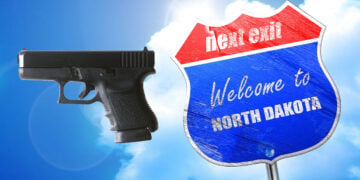Every so often, it is interesting to see how one firearm stacks up against another. I hope that you find the comparison that follows informative if you are considering the purchase of a Bersa 9UC or the SIG Sauer P239.
At first appearance, it would seem that the SIG P239 and the Bersa Thunder 9UC Pro are related in some way. Although they may be close in size, any comparison ends at that point.
At 29.5 ounces (unloaded w/magazine) the SIG P239 is the heavier of the two with the Bersa weighing in at 23 ounces.
The grip is longer and narrower on the Sig P239 compared to the Bersa 9UC, as it is an 8-round, single-stack configuration as compared to the Bersa’s 13-round (or 10 round), staggered magazine configuration. I like the grip of the SIG P239 over the Bersa 9UC for two reasons; My Hogue finger-groove gripped P239 fits my hand better than the Bersa and I have never been hammer-bitten by it as I have with the Bersa. If you get to high on that back strap with the Bersa, you will bear the same scar as I have on the web of my shooting hand. The SIG P239 has a higher bore axis and you can get as high on the grip as you think necessary and still not be bitten by the hammer.
The controls of the two pistols are, of course, different. The SIG P239 controls are, from front to rear, as follows: takedown lever, decocking lever, and slide lock lever. The Bersa Thunder 9UC controls are, from front to rear, as follows: takedown lever, slide lock lever, and decocking/safety lever. The SIGT P239 does not have an external safety, simply a decocking lever and it plays no other role. Controls, with the exception of the slide release lever, are ambidextrous on the Bersa. Controls on the SIG P239 are not ambidextrous – at least not on the model that I currently have.
The decocking lever controls the decocking of the SIG P239 and allows you to lower the hammer as fast or as slow as you want. The Bersa 9UC is just the opposite: with the pistol cocked and you move the decocking/safety lever into the “safe” position (up), the hammer falls with authority. That unnerves me at times. With my Bersa, I hold the hammer with the left thumb and forefinger while pulling the trigger to rest the hammer. From there, I have the option to leave it in “safe-mode” or take the safety off for a double-action first shot. I am comfortable with either mode. The decocking/safety lever on the Bersa is stiff at first but wears in after time.
The triggers are, surprisingly, not that different between the two. The 10-pound double-action trigger pull on the P239 is brief as compared to the trigger on the Bersa 9UC. On my guns, and they have been broken in, the triggers feel smooth with the P239 breaking a little sooner and cleaner than the Bersa. In single-action mode, the triggers actually feel close to each other with the P239 breaking at 4.5 pounds and the Bersa breaking at 5 pounds. Note; however, that the Bersa is not broken in and the trigger is still somewhat stiff. My Bersa 45UC trigger breaks right at 4.5 pounds consistently.
I prefer the SIG sights to the Bersa’s 3-dot sight arrangement. The SIG sight, with its front-dot rear-bar arrangement, has always worked for me over trying to line up three dots. However, The Bersa does have a larger front dot than those found on the rear sight and is good enough for “combat” use.
The P239 has a longer barrel (3.6-inches) than the Bersa (3.25-inches), but not significantly so to make a difference.

The Nitron finish on the stainless-steel slide of the P239 is far better than the finish on the Bersa. The finish on the Bersa is mottled and is common to some Bersa pistols that suffered from a chemical reaction of the plastic bag used for shipping and the guns finish. It does not take away from the gun’s accuracy or operation, but I would like the BG to be impressed with the looks of the gun that he is about to be shot with; it’s just a pride thing. The finish on one Bersa 9UC Pro is good while the finish on my other one is not as good. I will probably try to get that one refinished at some point – or not. If you go for the Bersa, check the finish. I heard that Bersa corrected the chemical reaction problem on later shipments.

You can change the grips on the SIG P239 to another type, such as wood or rubber. With the Bersa, you are pretty much stuck with what comes with it. The Bersa grips; however, are checkered nicely for a good grip and I have no problem with them. With that said, the Qwik Grip for the Glock G19 tightly fits the grip of the Bersa 9UC and does help to prevent the gun’s grip from twisting in the hands when firing the gun.
Enough of this nonsense; let us get to the shooting part! Both guns have full-length guide rods and full-length support rails to help accuracy. Both have good triggers and both shoot the same caliber of ammunition. The Bersa 9UC has 13+1 rounds (or 10-rounds) vs. 8+1 rounds of ammunition in the SIG P239. The bottom line is that I shoot the P239 better than I do the Bersa but I would not have any problem carrying the Bersa. In fact, I normally carry the 45UC when I am not carrying the Glock G36.
Perhaps, it is the slim grip, my hand position when firing, or the dot-bar sight arrangement, but I shoot the P239 very well and I shoot the Bersa well enough for combat and that’s well enough for me.

Summary:

If weight of the gun is an issue, go with the Bersa, as it is the lighter of the two. That is the primary reason that I retired the P239, it was just getting too heavy to carry for long periods. With the Bersa, I give up less muzzle flip to a lighter gun, but it is not that big of an issue.
If the number of rounds is an issue, go with the Bersa.
If you prefer ambidextrous controls go with the Bersa, as the slide lock lever and decocking/safety levers are ambidextrous.
If you like guns with hammers, either will work.
If the grip is an issue, go with whatever fits your hand better. It’s far better to shoot 8+1 rounds downrange accurately and with precision, than it is to shoot 13 + 1 rounds downrange not so accurately or not so precise because the gun does not fit your hand.
If weight, gun-to-grip, and ammo capacities are all issues – forget the whole thing and get a Glock G19 (29.98 oz. loaded, 15-round magazine, 4.02 in. barrel, and a 1.18 in. width) or G26 (26.10 oz. unloaded, 10-round magazine, and 3.46 in. barrel, and a width of 1.18 in. Both guns are slimmer than the P239 and the Bersa Thunder 9UC Pro and have the option of using magazines up to 33 round capacity. I added +1 extended base plates to my G26 magazines, which provides an 11 + 1 capacity, is a very light carry in my Galco King Tuck, and the price falls between the Bersa and the SIG. I normally carry two G19 (15-round) magazines for spares when I do carry the gun.
Each gun (SIG P239 and Bersa Thunder 9UC Pro) stands on its own merits. If I want a high-quality pistol, the SIG P239 wins without further discussion. If I am looking for a utility pistol with quality, the Bersa Thunder 9UC Pro will hold its own. Both guns are “combat accurate” (I really have to do a write-up about that term) and will put the needed rounds downrange; one does it very effectively while the other does it very effectively with panache.
If you ask me which of the pistols discussed I would grab when the SHTF, I would have to say the Glock.
With the exception of the finish and occasional hammer-bite, I have no issues with the Bersa.
With the exception of the weight, I have no issue with the SIG P239.
With the exception of price, I have no issue with either but feel that either, along with a shotgun and a rifle, should be provided at birth (to be available later for self-defense) along with your birth certificate and with the bill for the hospital going to your parents.









